Mauthausen Concentration Camp Victims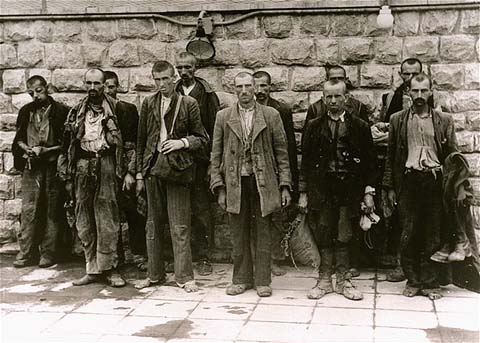 Prisoners at the Mauthausen and Gusen concentration camps in Austria were treated more harshly than at any other camp in the Nazi system. These two camps were the only ones that were classified as Class III camps which were "punishment camps." The day-to-day life in the two camps was supervised by common criminals who had been sentenced by a German court to hard labor. However, the German criminals were given easy jobs as privileged Kapos at Mauthausen. They were the slave drivers who beat the other prisoners unmercifully and forced them to work beyond their endurance, lifting heavy stones in the quarry. The Mauthausen victims were the innocent Jews who were typically given the hardest jobs, such as cleaning the latrines or working in the crematorium. They were the lucky ones; most of the Jews were worked to death in the quarries. They died within days or weeks of their arrival, after being forced to carry heavy granite stones from the quarry up the 186 "stairs of death" at a fast pace. Stories of atrocities told by the prisoners at Mauthausen indicate that the inmates were treated worse than at Auschwitz, if that's possible. For example, an American POW, identified only as Herbert J., who was a prisoner at Mauthausen, told the following story, which was published in a book entitled "Witness: Voices from the Holocaust": "I worked in, I suppose you would call it like a carpenter shop where they were working with wood. But I was anxious to get out of there because one of the men made a mistake cutting a piece of wood. And he tried to hide it, but he was seen. And the officer that was in charge there walked up, and he picked up the piece of wood and he looked at it and he looked at this guy. Then he grabbed him by the arm, and run his arm into the band saw and threw the hand over in the corner. Of course, the man run over and he picked up his arm and he's trying to put his arm back on. He died because - bled to death. You know, nobody helped him. Just bled to death. Herbert J. was with the Eleventh Armored Infantry Division of the US Army when he was captured by the Germans in 1945 and sent first to the Gusen concentration camp and then to Mauthausen. His story is unique because captured American Prisoners of War were typically sent to POW camps, as required by the Geneva Convention. According to Herbert J.'s account, which he gave to the authors of "Witness: Voices from the Holocaust," he was forced to work in the quarry at Mauthausen and his duties also included the care and feeding of the guard dogs. By 1945, the quarry at Mauthausen was no longer being worked and there was a Messerschmitt jet airplane factory in the quarry. All the Nazi concentration camps had a "dog handler" whose job it was to care for the guard dogs. The following is another story about Mauthausen, told by Herbert J. and quoted in "Witness: Voices from the Holocaust." "And this one American, we kept telling him, "Be quiet! Be quiet!" But he was very insolent and he was giving the Germans a lot of talk, a lot of language and whatnot. And he could speak a few words of German. And so I didn't speak any German at the time, so I didn't really understand what was going on. But the Germans were talking among themselves and pointing to him and laughing. They took us to Mauthausen and they staked him out, they stripped him and staked him out on the ground, just his arms outstretched, and his feet outstretched. But they didn't put any pressure on him or anything to hurt him, but they staked him down good and tight. So we went out and we asked him if he was cold, and he said he was. And so we got some old clothes and whatnot off some dead bodies and we come over and covered him over to try to keep him warm a little. But other than that, he wasn't in any pain. We didn't think much about it. If this is the kind of punishment you get, it wasn't so bad, you know. We went back inside, and come nighttime of course we went to sleep. And all of a sudden we hear screech, screaming and yelling and whatnot. We jumped up and we go rushing out. It's dark, and we're bumping into each other. We went over -- and a lot of the Russians had been there, like I say, for a number of years and had turned to cannibalism. We didn't realize it then, but they had so badly torn at his body that he died from the effects. He was bleeding to death, and nothing much we could do. This was why the Germans were laughing, because staking him out just left him available. After that, we used to watch each other's back." 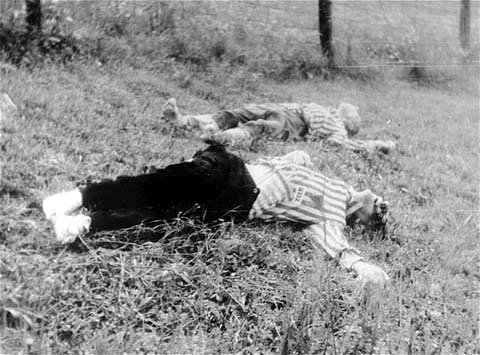 The photo above shows two prisoners who were shot "while trying to escape." Note the position of the bodies near a barbed wire fence. This was a favorite way for the guards to kill the prisoners, according to the survivors. Sometimes the guards would entice the prisoners to leave the work site by telling them to pick strawberries and then shoot them when they got near the fence. Or a guard would throw a prisoner's cap near the fence and when the prisoner tried to retrieve it, he would be shot. 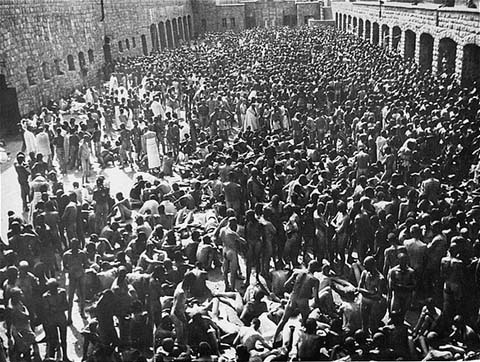 In the photograph above, six thousand prisoners are standing naked in the garage yard while their clothes are being disinfected in an effort to control the lice which spreads typhus. After being forced to stand there for 24 hours, 140 had dropped dead. Prisoners were routinely forced to take cold showers and then return naked to the courtyard where many died from exposure. A typical punishment was forcing a prisoner to stand in a cold shower for a half hour, according to the stories told by the survivors. In the last weeks before the camp was liberated, up to 400 prisoners were dying each day from typhus. Besides that, the gas chamber at Mauthausen was being used to murder prisoners right up until the night of April 28-29, 1945, according to Pierre-Serge Choumoff, a Gusen prisoner who wrote several books about Mauthausen. There was a shortage of coal to burn the bodies and when the American liberators arrived, there were bodies piled up outside the barracks, as shown the the first photograph below. 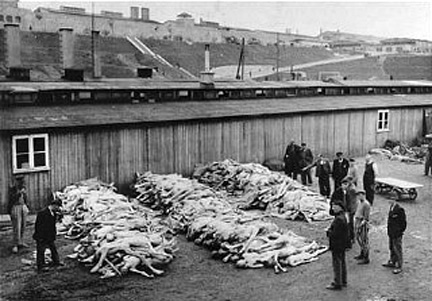 In the photograph below, two prisoners count the bodies piled up against a wall. The privileged prisoners in the camp were required to wear at least some part of the striped prison uniform. Note that these two prisoners are dressed in civilian jackets and hats, but have met the requirement by sewing a square of striped material onto their pants. On their jackets, they are wearing a triangle and a number which identifies them as prisoners. Their caps are the blue worker's caps worn by the Communists. 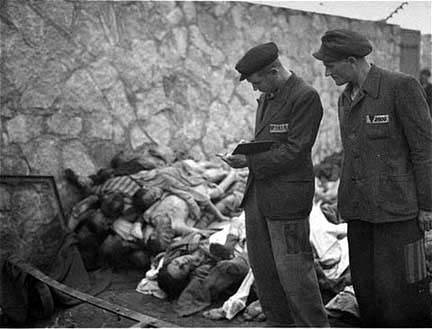 The prisoners were given a minimum amount of food, not enough to sustain a man doing heavy work. Breakfast was a cup of ersatz (substitute) coffee and a chunk of whole grain bread. At noon, the prisoners had a 45-minute break while they ate a large bowl of thin vegetable soup made from turnips or potatoes. The evening meal was more soup and bread. The prison diet was lacking in fat because only a small amount of margarine was served and rarely any meat. However, the Kapos lived high on the hog, cooking their own food in the barracks. They consumed large meals of luxury foods and even stole some of the goodies, like chocolate or canned sardines, out of the Red Cross packages, while the ordinary prisoners starved. Atrocity Stories told by Dutch SurvivorHomeThis page was last updated on December 30, 2007 |